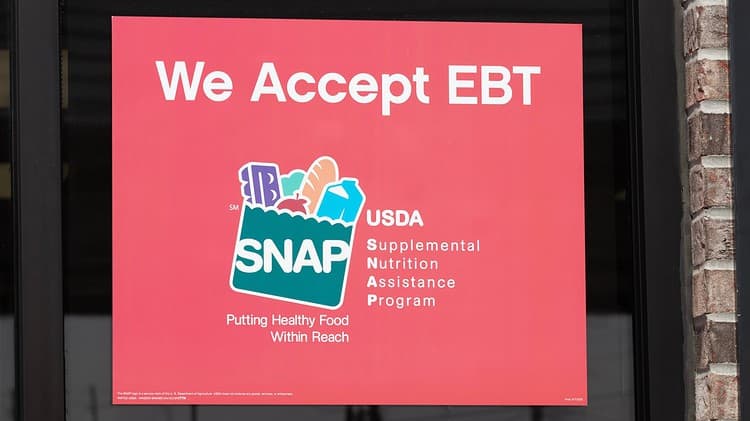Another week marks the end of a fantastic year for the Supplemental Nutrition Assistance Program (SNAP), which assists the most vulnerable people in purchasing food at EBT-accepting stores.
The Department of Children and Families (DCF) is in charge of managing and ensuring that SNAP benefits are distributed to eligible citizens each month in Florida.
The Food and Nutrition Service (FNS) and the United States Department of Agriculture (USDA) oversee the program’s administration at the federal level, while each state is responsible for its own local distribution.
The SNAP program has confirmed the people who will be eligible to receive benefits on Christmas
The Electronic Benefits Transfer (EBT) card is used to provide this assistance. Similar to a debit card, this card allows customers to make purchases at approved restaurants (it is usually prominently displayed).
Interested applicants can apply for SNAP benefits at their local office, online, or by mail. During the application process, all required paperwork, including proof of residency, income, and identity, must be submitted.
The SNAP program allows eligible households to buy the following items with their benefits:
- Fruits and vegetables
- Meat and fish
- Dairy products
- Breads and cereals
- Plants and seeds
However, according to USDA guidelines, beneficiaries cannot purchase alcoholic beverages, tobacco, vitamins, live animals, or foods that are hot at the time of purchase.
Which beneficiaries will be eligible to receive their SNAP benefits in Florida this Christmas?
According to data from the United States Department of Agriculture, SNAP payments for the State of Florida are made between the first and twenty-eighth of each month, based on the eighth and ninth digits of the beneficiary’s case number, in reverse order, and excluding the tenth digit.
This mechanism promotes the systematic distribution of funds every month. Below is the methodology used to deliver benefits in the state of Florida:
- Case Number: 79-81 (Payment received December 23)
- Case Number: 82-85 (Payment received December 24)
- Case Number: 86-88 (Payment received December 25)
- Case Number: 89-92 (Payment received Dec. 26)
- Case Number: 93-95 (Payment received Dec. 27)
- Case Number: 96-99 (Payment received on December 28)
When will other states receive their SNAP benefits in December?

Here you can find the December SNAP benefit payment schedule per state, according to the USDA:
- Alabama: December 4-23
- Alaska: December 1
- Arizona: December 1-13
- Arkansas: December 4-13
- California: December 1-10
- Colorado: December 1-10
- Connecticut: December 1-3
- Delaware: December 2-23
- District of Columbia: December 1-10
- Florida: from December 1 to 28
- Georgia: December 5 to 23
- Hawaii: December 3-5
- Idaho: December 1-10
- Illinois: December 1-10 and previous cases December 1-20
- Indiana: December 5-23
- Iowa: December 1-10
- Kansas: December 1-10
- Kentucky: December 1-19
- Louisiana: December 1-23
- Maine: December 10-14
- Maryland: December 4-23
- Massachusetts: December 1-14
- Michigan: December 3-21
- Minnesota: December 4-13
- Mississippi: December 4-21
- Missouri: December 1 to 22
- Montana: December 2-6
- Nebraska: December 1-5
- Snowfall: December 1-10
- New Hampshire: December 5
- New Jersey: December 1-5
- New Mexico: December 1-20
- New York: December 1-9
- North Carolina: December 3-21
- North Dakota: December 1
- Oklahoma: December 1-10
- Oregon: December 1-9
- Pennsylvania: December 3-14
- Rhode Island: December 1
- South Carolina: December 1-10
- South Dakota: December 10
- Tennessee: December 1-20
- Texas: December 1-28
- Utah: December 5, 11 and 15
- Vermont: December 1
- Virginia: December 1-7
- Washington: December 1-20
- West Virginia: December 1-9
- Wisconsin: December 1-15
- Wyoming: December 1-4
How much money do SNAP beneficiaries regularly earn per month?
Although the average payment varies by household size and income, as of October, the new payment amounts in each state are detailed below:
- Household size 1: $292
- Household size 2: $536
- Household size 3: $768
- Household size 4: $975
- Household size 5: $1158
- Household size 6: $1390
- Household size 7: $1536
- Household size 8: $1,756
Also See : Confirmed – The new Fairness Act for this 2025 – What is it and how does it affect you?
